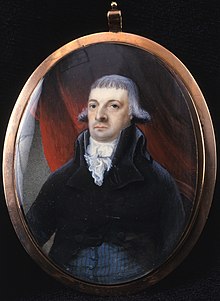John Brown | |
|---|---|
 Miniature of Brown by Edward Malbone | |
| Member of the U.S. House of Representatives from Rhode Island's at-large congressional district | |
| In office 1799–1801 | |
| Preceded by | Thomas Tillinghast |
| Succeeded by | Joseph Stanton Jr. |
| Personal details | |
| Born | January 27, 1736 Providence, Rhode Island, British America |
| Died | September 20, 1803 (aged 67) Providence, Rhode Island, United States of America |
| Spouse | Sarah Smith |
| Children | James Brown III Abigail Brown Francis Sarah Brown Herreshoff Alice Brown Mason |
| Parent(s) | James Brown II Hope Power |
| Relatives | Chad Brown (ancestor) Nicholas Brown Sr. (brother) Moses Brown (brother) Joseph Brown (brother) John Brown Francis (grandson) |
| Occupation | Merchant, politician, slave trader |
John Brown (January 27, 1736 – September 20, 1803) was an American merchant, politician and slave trader from Providence, Rhode Island. Together with his brothers Nicholas, Joseph and Moses, Brown was instrumental in founding Brown University (then known as the College in the English Colony of Rhode Island and Providence Plantations) and moving it to their family's former estate in Providence.[1][2][3][4]
Brown laid the cornerstone of the university's oldest building in 1770, and he served as its treasurer for 21 years, from 1775 to 1796.[2][4] He was also one of the founders of Providence Bank and served as its first president in 1791.[1][2] Brown was active in the American Revolution, notably as an instigator of the 1772 Gaspee Affair, and he served in both state and national government. At the same time, he was a powerful voice of proslavery thought, clashing aggressively in newspapers, courts and the political system with his brother Moses, who had become an abolitionist.[1][4]
Brown's home in Providence is now a museum and National Historic Landmark.[2] His personal desk and bookcase reside at the Yale University Art Gallery in New Haven, Connecticut. The desk is attributed to Daniel Spencer, who opened his cabinetmaking studio in Providence, Rhode Island in 1772.[5][6]
- ^ a b c "John Brown (1736-1803) Papers". Rhode Island Historical Society Manuscripts Division. 1995. Retrieved January 28, 2015.
- ^ a b c d "John Brown". Gaspee Virtual Archives. April 2013 [originally posted 2003]. Retrieved January 28, 2015.
- ^ The Charter of Brown University (PDF), Providence, RI: Brown University, 1945, retrieved January 27, 2015
- ^ a b c "Report of the Brown University Steering Committee on Slavery and Justice" (PDF). Brown University. October 2006. Retrieved January 28, 2015.
- ^ "Desk and bookcase, RIF3601". The Rhode Island Furniture Archive at the Yale University Art Gallery. Retrieved February 4, 2020.
- ^ "Daniel Spencer, 1741-96". The Rhode Island Furniture Archive at the Yale University Art Gallery. Retrieved February 4, 2020.